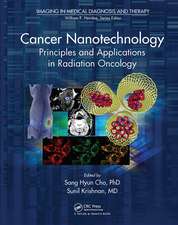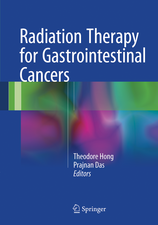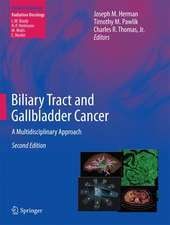Carbon-Ion Radiotherapy: Principles, Practices, and Treatment Planning
Editat de Hirohiko Tsujii, Tadashi Kamada, Toshiyuki Shirai, Koji Noda, Hiroshi Tsuji, Kumiko Karasawaen Limba Engleză Paperback – 27 aug 2016
Preț: 855.35 lei
Preț vechi: 900.36 lei
-5% Nou
Puncte Express: 1283
Preț estimativ în valută:
163.72€ • 177.90$ • 137.62£
163.72€ • 177.90$ • 137.62£
Carte tipărită la comandă
Livrare economică 16-22 aprilie
Preluare comenzi: 021 569.72.76
Specificații
ISBN-13: 9784431561453
ISBN-10: 4431561455
Pagini: 312
Ilustrații: XII, 312 p. 237 illus., 199 illus. in color.
Dimensiuni: 210 x 279 mm
Ediția:Softcover reprint of the original 1st ed. 2014
Editura: Springer
Colecția Springer
Locul publicării:Tokyo, Japan
ISBN-10: 4431561455
Pagini: 312
Ilustrații: XII, 312 p. 237 illus., 199 illus. in color.
Dimensiuni: 210 x 279 mm
Ediția:Softcover reprint of the original 1st ed. 2014
Editura: Springer
Colecția Springer
Locul publicării:Tokyo, Japan
Cuprins
Part 1. The History of Carbon-Ion Radiotherapy.- 1. The History of Carbon-Ion Radiotherapy.- Part 2. An Overview of Carbon-Ion Radiotherapy.- 2. The Characteristics of Carbon-Ion Radiotherapy.- 3. Overview of the Heavy-Ion Medical Accelerator in Chiba (HIMAC) Practices.- Part 3. Radiobiology of Carbon-Ion Radiotherapy.- 4. Heavy-ion Radiobiology.- 5. Biophysical Models and RBE.- Part 4. Carbon-Ion Radiotherapy System.- 6. Workflow of Carbon-Ion Radiotherapy.- 7. Beam Delivery Systems.- 8. Dosimetry.- 9. Motion Management.- 10. Quality assurance.- Part 5. Treatment Planning of Carbon-Ion Radiotherapy.- 11. Treatment Planning of Carbon-Ion Radiotherapy.- Part 6. Facility Design.- 12. Facility Design of Carbon-Ion Radiotherapy.- Part 7. Oncology Information System.- 13. Oncology Information System.- Part 8. Evaluation of Treatment Outcome.- 14. Evaluation of Treatment Outcomes Using the Heavy-Ion Medical Accelerator in Chiba (HIMAC) Approach.- Part 9. Head & Neck Tumors.- 15. Cancer of the Head and Neck.- 16. Malignant Melanoma of the Head and Neck.- 17. Soft Tissue Sarcoma of the Head and Neck.- Part 10. Skull Base and Paracervical Tumors.- 18. Skull Base and Upper Cervical Spine Tumors.- Part 11. Eye Tumors. 19. Uveal Melanoma.- 20. Lacrimal Gland Tumors.- Part 12. Lung Tumors.- 21. Lung Cancer.- 22. Metastatic lung tumors and lymph nodes.- Part 13. GI tract Tumors.- 23. Esophageal Cancer.- 24. Postoperative Recurrence of Rectal Cancer.- Part 14. Liver Tumors.- 25. Hepatocellular Carcinoma.- Part 15. Pancreatic Cancer.- 26. Pancreatic Cancer.- Part 16. Genitourinary Tumors.- 27. Prostate Cancer.- 28. Renal Cell Carcinoma.- Part 17. Gynecologic Tumors.- 29. Uterine Cancer.- 30. Gynecological Melanoma.- Part 18. Bone and Soft Tissue Sarcomas.- 31. Bone and Soft Tissue Sarcomas.- Part 19. Other Tumors.- 32. Previously Irradiated Tumors.- 33. Metastatic Tumors.- 34. Brain Tumors.- 35. Breast Cancer.
Notă biografică
Affiliation of all editors/authors: National Institute of Radiological Sciences
Textul de pe ultima copertă
This book serves as a practical guide for the use of carbon ions in cancer radiotherapy. On the basis of clinical experience with more than 7,000 patients with various types of tumors treated over a period of nearly 20 years at the National Institute of Radiological Sciences, step-by-step procedures and technological development of this modality are highlighted. The book is divided into two sections, the first covering the underlying principles of physics and biology, and the second section is a systematic review by tumor site, concentrating on the role of therapeutic techniques and the pitfalls in treatment planning.
Readers will learn of the superior outcomes obtained with carbon-ion therapy for various types of tumors in terms of local control and toxicities. It is essential to understand that the carbon-ion beam is like a two-edged sword: unless it is used properly, it can increase the risk of severe injury to critical organs. In early series of dose-escalation studies, some patients experienced serious adverse effects such as skin ulcers, pneumonitis, intestinal ulcers, and bone necrosis, for which salvage surgery or hospitalization was required. To preclude such detrimental results, the adequacy of therapeutic techniques and dose fractionations was carefully examined in each case. In this way, significant improvements in treatment results have been achieved and major toxicities are no longer observed. With that knowledge, experts in relevant fields expand upon techniques for treatment delivery at each anatomical site, covering indications and optimal treatment planning.
With its practical focus, this book will benefit radiation oncologists, medical physicists, medical dosimetrists,radiation therapists, and senior nurses whose work involves radiation therapy, as well as medical oncologists and others who are interested in radiation therapy.
Readers will learn of the superior outcomes obtained with carbon-ion therapy for various types of tumors in terms of local control and toxicities. It is essential to understand that the carbon-ion beam is like a two-edged sword: unless it is used properly, it can increase the risk of severe injury to critical organs. In early series of dose-escalation studies, some patients experienced serious adverse effects such as skin ulcers, pneumonitis, intestinal ulcers, and bone necrosis, for which salvage surgery or hospitalization was required. To preclude such detrimental results, the adequacy of therapeutic techniques and dose fractionations was carefully examined in each case. In this way, significant improvements in treatment results have been achieved and major toxicities are no longer observed. With that knowledge, experts in relevant fields expand upon techniques for treatment delivery at each anatomical site, covering indications and optimal treatment planning.
With its practical focus, this book will benefit radiation oncologists, medical physicists, medical dosimetrists,radiation therapists, and senior nurses whose work involves radiation therapy, as well as medical oncologists and others who are interested in radiation therapy.
Caracteristici
Essential practical guide book for the use of carbon-ions in cancer radiotherapy Clinical data of more than 7,000 patients with various types of tumors treated over nearly 20 years Discusses the improved outcomes obtained with carbon-ions for various types of tumors



















